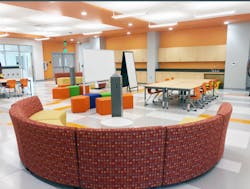Baltimore district opens first school under $1 billion facilities upgrade
The first building rebuilt under a $1 billion initiative to replace aging school facilities in the city of Baltimore has been unveiled by local and state officials.
The Baltimore Sun reports that the school district held a ribbon-cutting ceremony at the newly constructed $37 million Fort Worthington Elementary/Middle School. The building has a media studio, technology lab, efficient lighting and many other state-of-art amenities.
“What this gym says is that your physical well-being, your play, matters to us," Schools CEO Sonja Santelises said. "What the classrooms with amazing flexible spacing say is your ability to collaborate, your ability to create and innovate, matters to us. What the amazing technology in this building says is that we are not educating you for a past. We’re educating you for a future many of us adults will never see.”
Fort Worthington, along with the newly renovated Frederick Elementary School in Southwest Baltimore’s Mill Hill, will begin classes on Sept. 5. Seven other school buildings — including two scheduled for midyear openings — are under construction and several others are in the planning stages.
The building initiative, known as the 21st Century School Construction and Revitalization Program, is a partnership established by the Maryland General Assembly in 2013 with the city, the Maryland Stadium Authority, Baltimore City Public Schools and the Interagency Committee on Public School Construction. Between 23 and 28 schools are in line for renovations under the initiative.
Both Fort Worthington and Frederick were completed on schedule and under budget, says Eric Johnson, schools project executive for the stadium authority, which is overseeing the construction.
A major component of the plan involved closing underused schools and boosting the use of those that remained open. Students from what used to be Dr. Rayner Browne Elementary/Middle will move into Fort Worthington.
Students from Samuel F. B. Morse, which also closed, are joining those at nearby Frederick, which is a newly converted neighborhood charter school operated by the Baltimore Curriculum Project.
After plans for Fort Worthington were announced, members of the Berea Eastside Neighborhood Association protested because the neighborhood’s recreation center would have to be torn down to make room for the new school. School officials worked with the parks and recreation department to ensure that the center’s activities could still operate in the school building. For example, officials built the gym floor with a material that could support the former community center’s roller-staking program.
About the Author
Mike Kennedy
Senior Editor
Mike Kennedy, senior editor, has written for AS&U on a wide range of educational issues since 1999.
